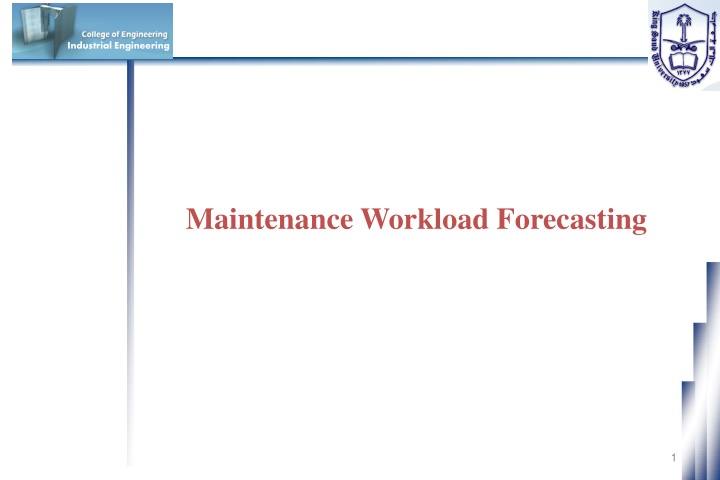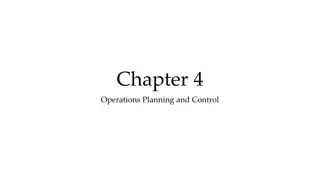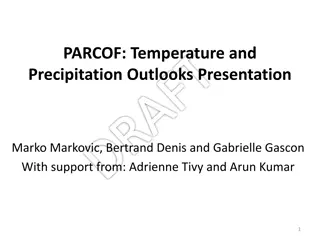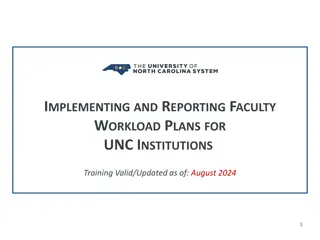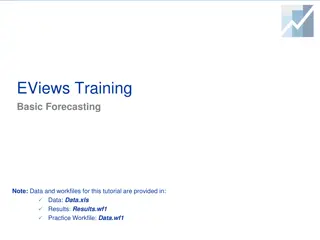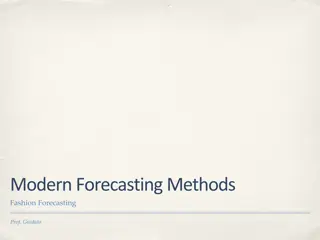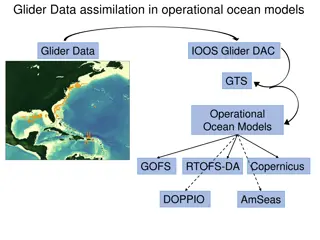Industrial Engineering Maintenance Workload Forecasting
Maintenance workload forecasting and capacity planning play vital roles in designing an effective maintenance system. This involves estimating maintenance load, categorizing maintenance works as planned or unplanned, and determining resources needed for capacity planning. Forecasting techniques include qualitative methods like surveys and the Delphi method, as well as quantitative methods based on mathematical models derived from historical data. Capacity planning involves determining the skills of craftsmen, equipment and tools required, spare parts, materials, backlog levels, overtime capacity, and contract maintenance.
Uploaded on Sep 15, 2024 | 4 Views
Download Presentation

Please find below an Image/Link to download the presentation.
The content on the website is provided AS IS for your information and personal use only. It may not be sold, licensed, or shared on other websites without obtaining consent from the author.If you encounter any issues during the download, it is possible that the publisher has removed the file from their server.
You are allowed to download the files provided on this website for personal or commercial use, subject to the condition that they are used lawfully. All files are the property of their respective owners.
The content on the website is provided AS IS for your information and personal use only. It may not be sold, licensed, or shared on other websites without obtaining consent from the author.
E N D
Presentation Transcript
Industrial Engineering Maintenance Workload Forecasting 1
Maintenance Load Industrial Engineering Maintenance forecasting and capacity planning are two important functions for the design of an effective maintenance system. Maintenance Load Forecasting Model Maintenance load forecasting comprises the estimation and predication of the maintenance load. This maintenance load represents the driving force of the whole maintenance system Forecasting Techniques 2
Maintenance Load Industrial Engineering Types of Maintenance Load : Maintenance Load Planned maintenance works which involves all the works that are characterized by their ability to be planned and scheduled. Forecasting Model Unplanned maintenance works which involves all works that are very difficult to be planned and scheduled. (These works depend primarily on the failure pattern and they are a major source of uncertainty in the planning process) Forecasting Techniques The sum of maintenance load in these two categories is a random variable and it is the major factor in determining the maintenance capacity. 3
Maintenance Load Industrial Engineering Capacity Planning Involves the determination of the maintenance resources that are needed to meet the maintenance load in order to achieve the organizational objectives such as: Maintenance Load 1. Availability Forecasting Model 2. Reliability 3. Quality rates 4. Delivery dates Forecasting Techniques 4
Maintenance Load Industrial Engineering The Essential Element of the Capacity Planning is the determination of : Maintenance Load Skills of craftsmen The exact number of various type of craftsmen Types of maintenance equipment and tools Forecasting Model The exact number of maintenance equipment and tools Spare parts and materials The right level of backlog Forecasting Techniques Overtime capacity Contract maintenance 5
Forecasting Model Industrial Engineering Forecasting techniques for determining maintenance load can be divided into: Maintenance Load Qualitative techniques: based on the expert or engineering experience and judgment. Such techniques are: Forecasting Model Surveys Delphi method: a group of experts respond individually to a questionnaire, providing forecasts and justifications. Results are combined, summarized, and returned to experts to revise. The process is repeated until consensus is reached Forecasting Techniques Quantitative techniques: based on mathematical models that drive from historical data estimates for future trends. They are either time series- based (moving average) or structural (regression models). 6
Forecasting Model Industrial Engineering The considerations used to select the forecasting technique are: Maintenance Load The purpose of the forecast The time horizon for the forecast Forecasting Model The availability of the data needed for particular technique. Forecasting Techniques 7
Forecasting Model Industrial Engineering The model is judged by the following criteria: Maintenance Load Accuracy which is measured by how accurately the model predicts future values, and is judged by the difference between the model forecasts and the actual observed values. Forecasting Model Simplicity of calculation, data needed, and storage requirements. Flexibility which is the ability to adjust to changes in conditions. Forecasting Techniques 8
Forecasting Techniques Industrial Engineering Qualitative Forecasting Techniques : Maintenance Load These techniques are used when these is no historical data available. The way to forecast the value of an item is through relying on the estimates of experts and their judgment. Forecasting Model The role of the analyst is to : Systematically extract information from the expert by using questionnaire and interviews. Help the expert to quantify his knowledge. Forecasting Techniques Identify which variables influence the forecast and the impact of each one. Reach an agreement on the magnitude of the variables and use them to estimate the magnitude of the variables that affect the forecast. 9
Forecasting Techniques Industrial Engineering Quantitative Forecasting Techniques : Maintenance Load These techniques are used when the historical data is available. The models uses these techniques assume either: Forecasting Model Future values follow historical trends. 1. A predictor (independent) variable exists that can provide a functional relationship that predicts (dependent) the characteristic under study. 2. Forecasting Techniques 10
Forecasting Techniques Industrial Engineering Types of Quantitative Forecasting Techniques: Maintenance Load Simple Moving Average Weighted Moving Average Forecasting Model Regression Analysis Exponential Smoothing Seasonal Forecasting Forecasting Techniques 11
Forecasting Techniques Industrial Engineering Seven Steps in Forecasting Maintenance Load 1. Determine the use of the forecast 2. Select the items to be forecasted 3. Determine the time horizon of the forecast Forecasting Model 4. Select the forecasting model(s) 5. Gather the data 6. Make the forecast Forecasting Techniques 7. Validate and implement results 12
Forecasting Techniques Industrial Engineering Moving Average Method Maintenance Load MA is a series of arithmetic means used if there is little or no trend and often for smoothing. It provides overall impression of data over time Demand in Previous n Periods = MA n Forecasting Model Forecasting Techniques 13
Forecasting Techniques Industrial Engineering Moving Average Method (Example) Maintenance Load If the maintenance load in man-hours for the last 6 months is given as Month 1 2 3 4 5 6 Maintenance Load 200 300 200 400 500 600 Forecasting Model Find the load forecast for periods 7 and 8 using a 3 month moving average. The forecasted load for month 7 using is + + 400 500 600 = = 7 x 500 3 Forecasting Techniques We did not observe x7, so if the load in month 7 is estimated as 500 as calculated above The forecast for the 8th month is obtained as: + + 500 600 3 500 = = 533 33 .. x8 14
Forecasting Techniques Industrial Engineering Weighted Moving Average Method Maintenance Load Used when trend is present Older data usually less important Weights based on experience and intuition Forecasting Model Disadvantages of Moving Average Methods Increasing n makes forecast less sensitive to changes Do not forecast trend well Forecasting Techniques Require much historical data 15
Forecasting Techniques Industrial Engineering Weighted Moving Average Method Maintenance Load Used when trend is present Older data usually less important Weights based on experience and intuition n = + = 1 x w x Forecasting Model n t t 1 i Disadvantages of Moving Average Methods Increasing n makes forecast less sensitive to changes Do not forecast trend well Forecasting Techniques Require much historical data 16
Forecasting Techniques Industrial Engineering Weighted Moving Average Method Maintenance Load Example Find the load forecast for periods 7 and 8 using a 3 month weighted moving average Forecasting Model = = = If . 0 25 5 . 0 w w w 5 4 6 x= + + = 025 400 . ( ) 025 500 . ( ) 05 600 . ( ) 525 7 x= + + = Forecasting Techniques 025 500 . ( ) 025 600 . ( ) 05 525 . ( ) 5375 . 8 17
Forecasting Techniques Industrial Engineering Exponential Smoothing Solution Maintenance Load Assigns weights to observations of previous periods in an inverse proportion to their age. = + ( ) x t x t ( 1 ) ( 1 ) ( x t 1 ) Forecasting Model where ( t x = the forecast for period t and all future periods in the case ) of a constant model. Forecasting Techniques ( t x ) 1 = actual demand at period t-1 = the forecasted value for t-1 ) 1 ( t x = smoothing constant, 18
Forecasting Techniques Industrial Engineering Exponential Smoothing Example Maintenance Load If the maintenance load in man-hours for the last 6 months is given as Month 1 2 3 4 5 Maintenance Load 800 600 900 700 600 Given that = 0.2 and F1 = D1, apply simple exponential smoothing to the data to forecast maintenance workload in month 6 Data and intermediate calculations for the simple exponential smoothing example = + 1 1 Forecasting Model ( ) x t ( ) ( ) ( x t 1 ) x t F1 = F2 = F3 = F4 = F5 = F6 = 800 0.2(800) + 0.8(800) = 800 0.2(600) + 0.8(800) = 760 0.2(900) + 0.8(760) = 788 0.2(700) + 0.8(788) = 770.4 0.2(600) + 0.8(770.4) = 736.32 Forecasting Techniques 19
Forecasting Techniques Industrial Engineering Trend Projections Fitting a trend line to historical data points to project into the medium-to-long-range Maintenance Load Linear trends can be found using the least squares technique ^ y = a + bx ^ Forecasting Model where y = computed value of the variable to be predicted (dependent variable) a = y-axis intercept b = slope of the regression line x = the independent variable Y = = + + a bX i i Y b > 0 Forecasting Techniques a b < 0 a Time, X 20
Forecasting Techniques Industrial Engineering Equations to calculate the regression variables Maintenance Load bt = + x t ( ) a Forecasting Model n n n ( ) ( ) x t n tx t t = = = 1 1 1 2 t i t = b n n 2 n t t Forecasting Techniques = = 1 1 t t = a x bt 21
Forecasting Techniques Industrial Engineering Example: Demand for a given spare part is given below for the last 4 years. Use linear regression to determine the best-fit straight line and to forecast spare part demand in year 5 Maintenance Load Year t Spare part demand D(t) 1 100 2 120 3 150 4 170 Intermediate calculations for the linear regression example Forecasting Model Sum 10 540 1470 30 1 100 100 1 2 120 240 4 3 150 450 9 4 170 680 16 t D(t) tD(t) t2 Forecasting Techniques 22
Forecasting Techniques Industrial Engineering Seasonal Forecasting Maintenance Load The demand for many products and services may follow a seasonal or cyclic pattern, which repeats itself every N periods. Maintenance workload may show seasonal variation due to periodic changes in demand, weather, or operational conditions Forecasting Model Forecasting Techniques 23
Forecasting Techniques Industrial Engineering Forecasting for Stationary Seasonal Data Maintenance Load 1. Calculate the overall average ; 2. Divide each point by the average to obtain seasonal factor estimate; 3. Calculate seasonal factors ct by averaging all factors for similar periods; ct= seasonal factor (multiplier) for time period t, 1 t N, Forecasting Model 4. Forecast by multiplying with the corresponding ct for the given period. Example The quarterly totals of maintenance work orders are given below for the last 3 years. Forecast the number of maintenance work orders required per quarter in year 4 Forecasting Techniques 24
Forecasting Techniques Industrial Engineering Step 1- sum of all data = 54,000 Overall average = 54,000/12 = 4,500 Maintenance Load Step 2 and 3- dividing data by 4,500 and averaging columns gives the values in the following table Forecasting Model Note that sum of the four seasonal factors (1.4444 + + 1.111) is equal to 4, which is the length of the cycle N (four quarters). Step 4- finally, the forecasted maintenance work orders for each quarter in year 4 are given by Forecasting Techniques F1 = 1.4444(4,500) 6,500 Quarter 1 F2 = 0.8889(4,500) 4,000 Quarter 2 F3 = 0.5556(4,500) 2,500 Quarter 3 F4 = 1.1111(4,500) 5,000 Quarter 4 25
Forecasting Techniques Industrial Engineering Forecasting for Seasonal Data with a Trend Maintenance Load The usual approach to forecast with seasonal-trend data is to estimate each component by trying to remove the effect of the other one. The approach to do that include: (1) remove trend to estimate seasonality, (2) remove seasonality to estimate trend, and (3) forecast using both seasonality and trend. Forecasting Model 1. Divide each cycle by its corresponding cycle average to remove trend. 2. Average the de-trended values for similar periods to determine seasonal factors c1, , cN. If ct N, normalize seasonal factors by multiplying them with N/ ct. 3. Use any appropriate trend-based method to forecast cycle averages. Forecasting Techniques 4. Forecast by multiplying the trend-based cycle average by appropriate seasonal factor. 26
Forecasting Techniques Industrial Engineering Example For a university maintenance department, the number of work orders per academic term is given below for the last 3 years. Forecast the number of maintenance work orders required per term in year 4. Maintenance Load Forecasting Model Calculations for seasonal factors (steps 1 and 2) are shown in following tables: Calculating cycle averages Forecasting Techniques 27
Forecasting Techniques Industrial Engineering Calculating seasonal factors by dividing by cycle averages Maintenance Load Forecasting Model There is no need to normalize seasonal factors since their sum (1.383 + 0.926 + 0.691) is equal to 3, which is the length of the cycle N (three terms). Using regression, calculations for the trend components of cycle averages (step 3) Forecasting Techniques 28
Forecasting Techniques Industrial Engineering Maintenance Load Forecasting Model The forecasting model for period (term) t of cycle (year) d is given by Fd, t = ct[6,000 +1,333.33d] Forecasted maintenance work orders required per term in year 4 are calculated as F 4, 1 = 1.383[6,000 +1,333.33(4)] = 15,674 Term 1 F 4, 2 = 0.926[6,000 +1,333.33(4)] = 10,495 Term 2 F 4, 3 = 0.691[6,000 +1,333.33(4)] = 7,831 Forecasting Techniques Term 3 29
Forecasting Techniques Industrial Engineering Error Analysis The following error measures are commonly used for error analysis and evaluation of forecasting models Maintenance Load Mean Absolute Deviation (MAD) N = ( ) 1 x t ( ) x t 1. = t MAD N Forecasting Model N = ( ) 2. Mean Squared Error (MSE) 2 x t ( ) x t ( ) = 1 t MSE N 3. Mean Absolute Percent Error (MAPE) N 100 x t ( ) x t ( ) = Forecasting Techniques = MAPE x t ( ) N 1 t 4. Mean Squared Percent Error (MSPE) 2 N 100 x t ( ) x t ( ) = = MSPE x t ( ) N 1 t 30
Forecasting Techniques Industrial Engineering A company wants to predict the maintenance workload of its mechanics for the first period of the next year. Before the company does that, it has been noted that in the first period of the next year, the company manufacturing plant will pass over circumstances similar to those that it faced in the first six months of the last year. What is the mechanics maintenance workload for the first period of the next year if the actual maintenance workloads for these mechanics in the previous periods are given in the following table ? Periods Actual Maintenance Workload (hours) 120 100 110 90 95 105 Periods Maintenance Workload (hours) 111 130 110 125 120 100 1 2 3 4 5 6 7 8 9 10 11 12 Example 31
Forecasting Techniques Industrial Engineering A manufacturing plant wants to predict the maintenance work load of its electricians for the next planning period in one of its manufacturing area. The engineers in the maintenance department found that during the last six periods, a percentage of the actual maintenance workload performed during each one of these periods represents a part of the forecasted maintenance work load for the electricians in the next planning period. In particular, they found the following: 1. 22% of the actual maintenance work load in the first period of the last six periods represents the first part of the forecasted maintenance work load of the electricians. 2. 18% of the actual maintenance work load in the second period of the last six periods represents the second part of the forecasted maintenance work load of the electricians. 3. 15% of the actual maintenance workload in the other remaining periods represents the remaining parts of the forecasted maintenance work load of the electricians 4. The actual maintenance workloads in the previous periods are given in the following table Example 32
Forecasting Techniques Industrial Engineering Periods Actual Maintenance Workload (hours) 150 130 160 100 130 110 1 2 3 4 5 6 Example 33
Forecasting Techniques Industrial Engineering Calculate the next planning period maintenance workload for a manufacturing area in a plant that has 12 machines, if the recent actual maintenance workloads reflect only 40% of the amount of this manufacturing area next period maintenance workload. The actual maintenance workloads in the previous periods are given in the following table Periods Actual Maintenance Workload (hours) 30 1 2 37 3 25 4 35 Example 5 20 34
Forecasting Techniques Industrial Engineering A company wants to predict the maintenance workload for the next planning period for one of its manufacturing area. The area has six machines in total. It started its production in the first two periods by using two of these six machines. After that, all of the six machines were operated to cover the production demand. These six machines will still be operated in the next planning period. The actual maintenance workloads in the previous periods for the same area are given in the following table 4. Find the next planning period maintenance workload. Periods Actual Maintenance Workload (hours) 60 50 360 345 336 330 Periods Actual Maintenance Workload (hours) 327 320 316 312 305 300 1 2 3 4 5 6 7 8 9 10 11 12 Example 35
